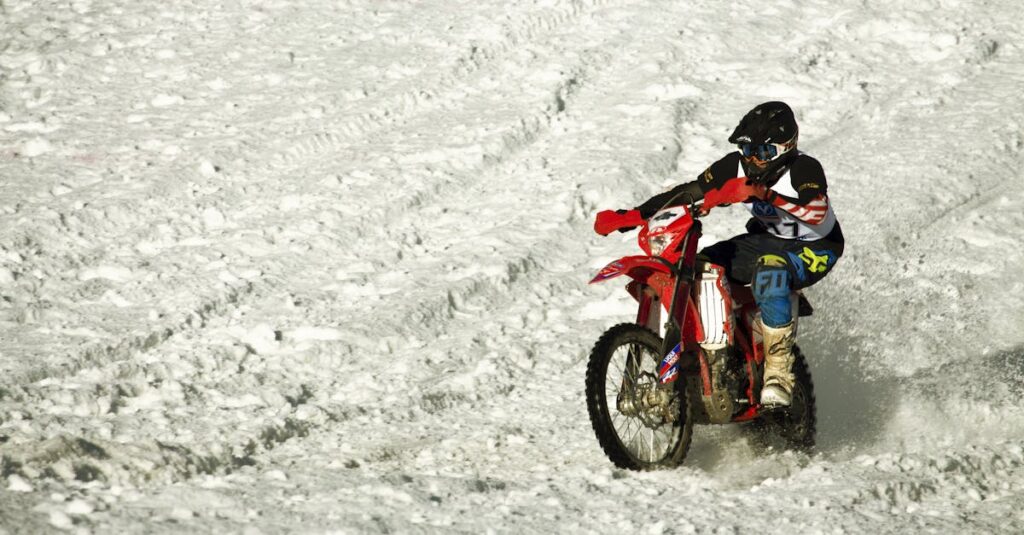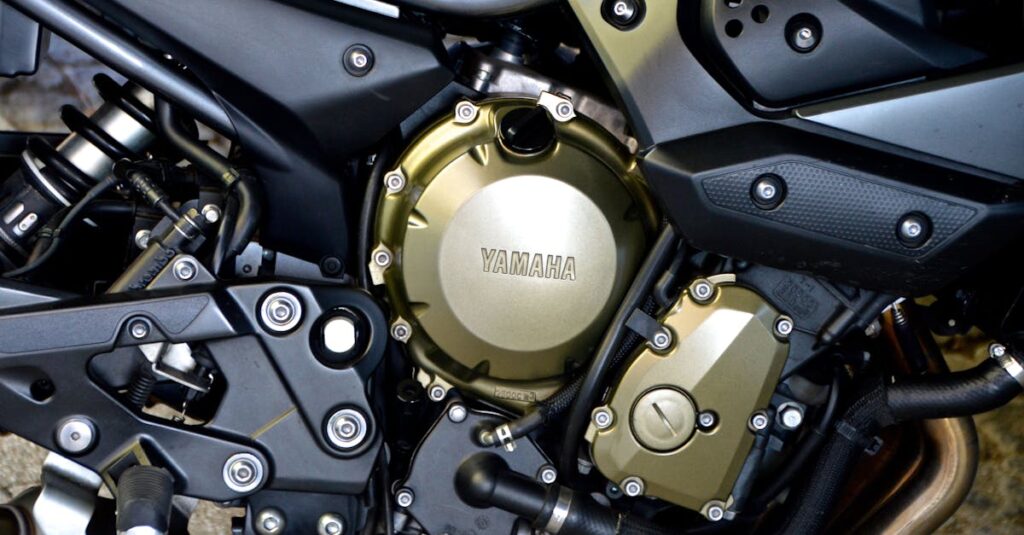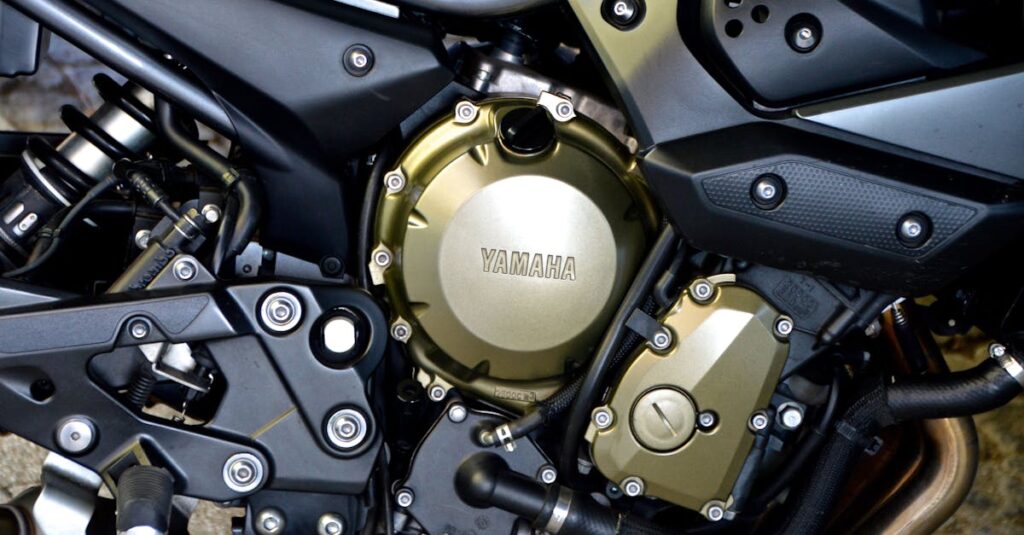Braving the winter chill on two wheels isn’t for the faint of heart. But with the right motorcycle gear riders can transform those bone-chilling rides into comfortable winter adventures. From heated gloves to thermal base layers every piece of winter riding equipment plays a crucial role in keeping motorcyclists safe and warm.
As temperatures drop seasoned riders know that regular motorcycle gear just won’t cut it. Whether it’s commuting to work or embarking on a winter road trip proper cold-weather protection becomes essential. Modern winter riding gear combines advanced materials insulation technology and smart design to create a barrier against the elements while maintaining mobility and comfort on the bike.
Motorcycle Winter Gear
Quality winter motorcycle gear protects riders in temperatures below 50°F through specialized insulation technology. Advanced thermal protection combines with moisture-wicking properties to maintain optimal body temperature during cold rides.
Base Layers
- Merino wool thermal underwear regulates temperature while preventing moisture buildup
- Compression fit base layers enhance blood circulation for added warmth
- Moisture-wicking synthetic materials prevent sweat accumulation in critical areas
- Seamless construction eliminates pressure points under outer gear
Outer Protection
- Insulated textile jackets with removable thermal liners accommodate temperature changes
- Waterproof Gore-Tex membranes block wind penetration while maintaining breathability
- Reinforced pants with thermal quilting protect legs from freezing winds
- High-visibility elements enhance safety during limited winter daylight conditions
Extremity Protection
- Battery-powered heated gloves maintain finger dexterity in sub-freezing conditions
- Insulated motorcycle boots with waterproof membranes keep feet dry
- Thermal socks with moisture-wicking technology prevent cold spots
- Neck gaiters seal gaps between jacket collars helmets
- Full-face helmets with anti-fog visors provide complete facial coverage
- Pinlock inserts prevent visor fogging in cold temperatures
- Balaclavas create thermal barriers between skin helmet padding
- Wind-resistant skull caps add extra insulation under helmets
| Temperature Range (°F) | Recommended Layers |
|---|---|
| 50-40 | Base layer + Regular gear |
| 40-30 | Base layer + Thermal liner + Outer shell |
| Below 30 | Base layer + Mid layer + Heated gear + Outer shell |
Protecting Your Core with Winter Base Layers
Base layers create the foundation for effective cold-weather motorcycle riding protection. These specialized garments work directly against the skin to regulate body temperature through insulation and moisture management.
Thermal Underlayers and Heat-Retaining Materials
Thermal base layers incorporate advanced synthetic fibers and merino wool to create an effective barrier against cold temperatures. Merino wool offers superior insulation properties with a warmth-to-weight ratio 40% higher than synthetic materials. Common thermal materials include:
- Polypropylene fibers trap body heat in microscopic air pockets
- Merino wool regulates temperature between 30°F to 70°F
- Polyester blends provide durability with 4-way stretch
- Ceramic-infused fabrics reflect up to 60% of body heat
Modern thermal layers feature anatomical mapping technology that places thicker insulation in core areas like the chest and upper back while using lighter materials in high-movement zones.
Moisture-Wicking Technology
Moisture management systems actively transport sweat away from the skin to prevent dangerous cooling effects during winter rides. Advanced wicking materials move moisture at rates up to 30% faster than traditional cotton layers. Key moisture control features include:
- Dual-layer fabrics separate moisture from insulation
- Hydrophobic thread treatments repel water molecules
- Quick-dry fibers evaporate moisture in under 30 minutes
- Multi-channel yarn structures create efficient moisture paths
These technologies maintain a dry microclimate next to the skin by pushing moisture through the fabric’s outer surface where it can safely evaporate without compromising the thermal protection.
Cold Weather Motorcycle Jackets and Pants
Cold weather motorcycle jackets and pants form the primary defense against winter elements during rides. These specialized garments combine multiple protective layers with advanced insulation technology to maintain rider warmth in temperatures below 50°F.
Waterproof and Insulated Options
Cold weather motorcycle gear uses Gore-Tex waterproof membranes combined with 3M Thinsulate insulation to create an impenetrable barrier against rain and snow. Premium winter jackets incorporate D3O armor panels at impact zones while maintaining flexibility through articulated joints. Multi-layer construction pairs water-resistant outer shells with removable thermal liners rated for temperatures down to 20°F. Adventure-style pants feature reinforced panels at high-wear areas with sealed seams to prevent water infiltration. Manufacturers like Klim and Alpinestars integrate reflective panels on shoulders sleeves and thighs to enhance visibility in low-light conditions.
Ventilation Features for Temperature Control
Strategic ventilation systems allow riders to regulate body temperature through zippered vents positioned at chest back and arms. Direct-to-body air channels create efficient cooling paths when temperatures fluctuate during winter rides. Removable storm collars and adjustable waist cinches customize the fit to prevent cold air entry points. Advanced moisture management systems direct perspiration away from the body through microscopic pores in the fabric. Side zippers on pants enable quick ventilation adjustments without removing boots. Mesh-lined pockets double as additional venting options when temperatures rise above freezing.
Winter Motorcycle Gloves and Hand Protection
Motorcycle winter gloves protect riders’ hands from extreme cold temperatures while maintaining essential control sensitivity. The right gloves combine insulation properties with tactile feedback for safe winter riding.
Heated Gloves vs Traditional Winter Gloves
Heated motorcycle gloves generate warmth through battery-powered heating elements embedded in the fabric. These gloves offer 3 to 4 temperature settings ranging from 95°F to 135°F with battery life lasting 2 to 6 hours per charge. Traditional winter gloves rely on Thinsulate insulation rated between 100g to 200g combined with windproof materials like Gore-Tex. Heated options excel in temperatures below 35°F by maintaining consistent warmth whereas traditional gloves become less effective as temperatures drop. Many riders pair heated gloves with handlebar muffs for maximum protection in extreme conditions.
Grip Requirements and Safety Features
Motorcycle winter gloves incorporate silicone palm patterns with textured leather panels to maintain grip control in wet conditions. Premium models feature titanium or carbon fiber knuckle protection alongside TPU sliders on impact zones. Touch-screen compatible fingertips allow GPS device operation without removing gloves. Double-stitched seams reinforce high-stress areas while gauntlet-style cuffs extend over jacket sleeves to block wind infiltration. Reflective piping increases visibility during low-light winter rides. Waterproof membranes keep hands dry through rain exposure extending up to 4 hours.
Winter Boots and Footwear Solutions
Motorcycle winter boots incorporate 3M Thinsulate insulation rated for temperatures down to 15°F. Premium riding boots feature waterproof Gore-Tex membranes paired with moisture-wicking liners to maintain dry feet during extended rides.
Key features of winter motorcycle boots include:
- Reinforced toe boxes with impact protection zones
- Slip resistant Vibram soles for secure footing
- Reflective panels for increased visibility
- Gusseted tongues to block water infiltration
- Quick release fastening systems for easy access
Layering strategies enhance boot performance in cold conditions:
- Merino wool socks provide base insulation
- Heated sock liners activate via portable batteries
- Waterproof gaiters create additional weather barriers
- Boot covers add wind protection layers
| Boot Temperature Rating | Recommended Use Case |
|---|---|
| 50°F – 32°F | Standard winter boots |
| 32°F – 15°F | Insulated riding boots |
| Below 15°F | Heated boot systems |
Advanced winter boots integrate removable thermal liners with antimicrobial treatments. Strategic placement of armor protects ankles while maintaining flexibility for gear shifts. Side entry zippers enable quick transitions while waterproof overlays prevent moisture intrusion.
- Dual compound rubber soles
- CE certified ankle protection
- 400g insulation density
- Anatomically shaped footbeds
- Sealed seam construction
Face and Neck Protection for Winter Riding
Face and neck protection create an essential barrier against frigid winds during winter motorcycle rides. Exposed areas around the helmet require specialized gear to maintain warmth and visibility in cold conditions.
Balaclavas and Neck Warmers
Motorcycle balaclavas combine merino wool and moisture-wicking synthetics to protect the entire head and neck region. Premium models feature ergonomic designs with flat-lock seams to prevent pressure points under helmets. Multi-panel construction creates targeted insulation zones:
- Windproof panels shield the forehead and cheeks from direct airflow
- Breathable mesh sections near the mouth prevent visor fogging
- Extended neck coverage tucks into jacket collars to block drafts
- Dual-layer thermal zones trap warm air around ears and nape
Neck warmers complement balaclavas with additional protection. Technical features include:
- 4-way stretch fabric allows unrestricted head movement
- Thermal fleece interior rated to 20°F
- Moisture-wicking treatment prevents sweat buildup
- Velcro closures enable quick adjustment while riding
Heated Visors and Anti-Fog Solutions
Visor clarity remains critical for safe winter riding through integrated heating and anti-fog technologies. Electric heated visors connect to motorcycle batteries to maintain clear vision in temperatures down to 15°F. Key anti-fog features include:
- Pinlock inserts create dual-pane thermal barriers
- Hydrophobic coatings repel moisture and prevent condensation
- Ventilation channels direct airflow to reduce humidity
- Built-in resistive heating elements maintain consistent temperature
- Quick-release mechanisms for easy lens changes
- UV protection layers that block 99% of harmful rays
- Anti-scratch coatings for extended durability
- Integrated defrost patterns for rapid clearing
Storing and Maintaining Winter Motorcycle Gear
Proper storage extends the life of winter motorcycle gear between riding seasons. Clean gear thoroughly before storage using manufacturer approved products to remove dirt, salt deposits, and perspiration residue.
Storage locations require these specific conditions:
- Temperature between 60°F to 70°F
- Humidity levels below 50%
- Protection from direct sunlight
- Adequate air circulation
- Distance from heat sources
Heated gear components need these maintenance steps:
- Remove batteries from heated elements
- Test electrical connections for corrosion
- Clean contact points with electronic cleaner
- Store wiring harnesses coiled loosely
- Check battery chargers for damage
| Item | Cleaning Method | Storage Container |
|---|---|---|
| Base Layers | Machine wash cold, hang dry | Breathable garment bag |
| Outer Shells | Hand wash, air dry | Heavy duty hangers |
| Boots | Clean with leather cleaner | Boot trees |
| Gloves | Hand wash, reshape while drying | Glove forms |
Leather items require these preservation steps:
- Apply leather conditioner every 3 months
- Insert cedar shoe trees in boots
- Use glove forms to maintain shape
- Store flat or hung to prevent creases
Waterproof membranes maintain effectiveness through:
- Regular reapplication of DWR treatment
- Testing water beading every 6 months
- Storing uncompressed to preserve coating
- Professional cleaning annually
- Storing in moisture proof containers
- Running systems monthly during storage
- Maintaining partial battery charge
- Replacing damaged wiring immediately
Winter motorcycle riding demands specialized gear that goes beyond standard equipment. By investing in quality winter-specific items riders can safely enjoy their two-wheeled adventures even in challenging cold conditions.
Modern motorcycle winter gear combines advanced materials thermal technology and smart design features to create a comprehensive defense against harsh weather. From heated gloves to insulated boots each piece plays a vital role in maintaining comfort and safety.
The right combination of winter riding gear transforms cold-weather motorcycling from an ordeal into an enjoyable experience. With proper maintenance these specialized items will provide reliable protection season after season letting riders extend their riding calendar throughout the winter months.



